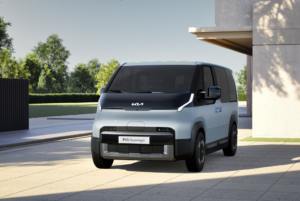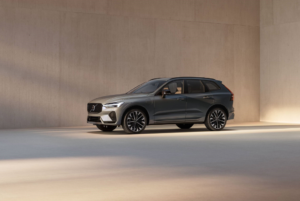
Ahead of the 2024 Beijing motor show (Auto China 2024), the Volkswagen Group unveiled the ID.Code concept, which gives a sneak peek at a new line of electric vehicles being developed in partnership with Volkswagen’s numerous joint venture partners in China. Thomas Schafer, CEO of Volkswagen, claims that the concept SUV-coupe features a sleek new design language created specifically for Chinese automakers.
The ID.Code will develop into a new flagship model to sit atop Volkswagen’s recently announced ID UX Chinese EV family. It is based on an unnamed platform architecture that is said to support both single-motor rear-wheel drive and dual-motor four-wheel drive, as well as varying battery capacities and ranges.
Exterior of Volkswagen ID.Code
The new four-seater sports a unique front end with flamboyant headlight style and an illuminated Volkswagen emblem, which, according to Volkswagen, resonate strongly with younger EV buyers in China. It differs significantly in appearance and packaging from today’s ID-badged vehicles. Andreas Mindt, the head of design at Volkswagen, called the ID.Code “distinguished” and “inspiring.” “It’s more expressive and thoroughly contemporary than any of our existing models,” he remarked.
The previous head of Bentley design claimed that attempts had been made to incorporate light animations, such as a feature that is quite welcome—headlights that simulate eye blinking—to give the new concept human-like characteristics. “We intended to provide the ID.Give the code a kind, human touch. As soon as you see it, it ought to evoke a visual reaction. It’s not chilly and robotic,” he said in an interview with our sister magazine Autocar UK. With over-the-air software upgrades available to subscribers, the light animations are designed to be changed every three months to update the appearance of the vehicle.
The new Volkswagen concept has more traditional proportions than the current, cab-forward ID models thanks to its clean, low front-end with an undercut design in place of a traditional grille, which continues into a long bonnet, sloped windscreen, and curved roofline. A comparatively shallow glasshouse and a high waistline serve to further emphasize this. Other distinctive features include the massive wheelhouses that are situated above the rear haunches and the prominent front wheel arches. Wide tracks give a strong stance and should improve stability when driving, while an extended wheelbase also aids in reducing overhangs.
As a part of what Volkswagen refers to as its “Smart Window Concept,” an avatar that provides information on traffic and weather conditions emerges on the driver’s side window when you approach it with the key. Volkswagen is attempting to catch up to its Chinese competitors in terms of digital capabilities. Located in a shooting brake-style tailgate and adorned with an illuminated emblem, the ID.Code features a highly tilted rear glass and horizontal brake lights that reflect the headlights. Mindt’s assertion that the new idea was developed with equal consideration for style and space is supported by the strong tapering towards the corners.
Interior, Features of Volkswagen ID.Code
The 4,800mm-long concept car has a progressive exterior style and a new driver-centric interior design that revolves around AI-supported infotainment features and advanced Level 4 autonomous driving, which is indicated by lidar units that illuminate the car’s exterior when it is driving itself. The ID UX electric car sub-brand was developed to offer a wide range of electric lifestyle-oriented cars, with the goal of targeting a younger demographic than Volkswagen’s current ID model lineup. According to Schafer, “The ID.Code offers the first glimpse of Volkswagen’s future in China.” “It’s a component of a refined brand experience meant to reach new Chinese markets.”
The new concept’s concepts, technologies, and procedures are intended to put next Volkswagen models more directly in competition with those from more recent electric vehicle start-ups like Nio, Xpeng, Aito, and Li Auto, as well as more established Chinese automakers.
Beyond China: Volkswagen ID.Code
Insiders at Volkswagen’s design headquarters in Wolfsburg, Germany, say that although the new design language was created for cars to be marketed in China, discussions are already underway over how it might affect future models intended for sale in Europe.
“We’ve shown how we will progress the look of electric models for Europe with the ID.2 and ID.2 GTI. They’re more traditional in terms of styling,” said Mindt. “However, we are not ruling out a car like the ID.Code being introduced to other markets in the future. For now, though, it is only planned for China.”
Volkswagen China’s future plans
The ID Unyx, a rebadged Cupra Tavascan manufactured at a joint-venture facility run in cooperation with JAC in the Chinese city of Hefei, is the first model in the ID UX lineup. An essential component of Volkswagen’s “In China, for China” strategy, it is an expansion of the current ID lineup designed specifically for the Chinese market.
Apart from models built on its current MQB (ICE) and MEB (EV) platforms, Volkswagen intends to introduce new models on the EE electric car platform, which is being developed in collaboration with Xpeng, and a brand-new electric car platform known as the China Main Platform (CMP) starting in 2026. In China, Volkswagen has also partnered with Horizon Robotics and Thundersoft to create infotainment, networking, and autonomous driving technologies.


